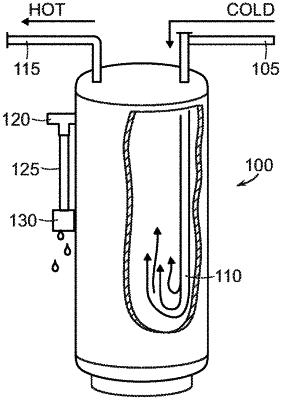| CPC G01F 1/56 (2013.01) [F16K 17/003 (2013.01); G01F 15/005 (2013.01); G01M 3/26 (2013.01)] | 31 Claims |

|
1. A hot water heater assembly with a fluid discharge event detection apparatus, comprising:
a hot water heater having a tank;
a first conduit connected to the tank;
a temperature and pressure relief valve having an inlet coupled to the first conduit, the temperature and pressure relief valve also having an outlet;
a sensing conduit coupled to the outlet of the temperature and pressure relief valve, wherein the temperature and pressure relief valve is configured to open and fluidly couple the first conduit and the sensing conduit to one another, wherein the temperature and pressure relief valve is normally closed and mechanically opens to discharge water through the outlet based upon predetermined temperature and pressure conditions being exceeded;
a sensor, disposed and positioned around an exterior of the sensing conduit and entirely outside of an interior of the sensing conduit so that water flow is not diverted, obstructed or restricted and the sensor is never in contact with the water, the sensor being configured to output a signal proportional to a capacitance of the sensing conduit; and
a controller, coupled to the sensor, configured to periodically:
measure a capacitance value of the sensing conduit as a function of the sensor output signal;
detect a change in the measured sensing conduit capacitance value; and
assert an alarm condition upon detection of the change in the measured sensing conduit capacitance value, wherein the alarm condition is configured to indicate a no flow condition when the sensing conduit is dry, a some flow condition when the sensing conduit is under 25% wet, or a full flow condition when the sensing conduit is more than 25% wet based on the measured capacitance value of the sensing conduit.
|